Supporting a Circular Economy with Safe, Sustainable Inks and Coatings
A high-level overview for Brand Owners, Packaging Leaders, and Printers
Inks are often not the first priority when a company thinks about achieving its sustainability goals and realizing a circular economy, but they play an important role. If you are a brand manager or packaging engineer, there are plans and practices that you can implement to positively impact the sustainability of your package and your brand.
Natural-Based, Bio-Renewable Inks and Carbon Footprints
Do you have any natural or bio-renewable inks? As a global manufacturer and provider of ink and coating solutions and technologies for commercial, packaging, and digital applications, we’ve been asked that question too often to count—by printers, converters, and brand owners. There is a lot of confusion about natural-based, bio-renewable inks. “Bio-renewable” is a term used to label and differentiate natural and sustainable resources from those derived from fossil fuels. In most cases, a printing ink can replace traditional, petrochemically derived ingredients with clean, renewable, and sustainable ingredients without sacrificing machine, processing, and end use product performance.
DOWNLOAD
Dart Container achieves measurable carbon and VOC emissions reductions.
Download Case Study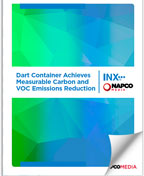
Natural-based, renewable materials that are responsibly sourced and considered for their end-of-life recovery provide a path to measurable, reportable CO2 savings and ultimately help brands tell a stronger sustainability story. As an example, INXhrc™ Natural-based inks contain 50 to 90 percent (depending on the application and intended use) natural ingredients and are free of allergens, nanomaterials, fluorochemicals, fanal pigments, heavy metals, latex, and PTFE; and, they have a 25 to 30 percent lower CO2 footprint than standard aqueous inks1.
There are different methods of determining the renewable content of ink. The National Association of Printing Ink Manufacturers (NAPIM) launched its BioRenewable Content (BRC) program in response to both printer and print buyer demands for information related to their supply chain efforts aimed at reducing or minimizing environmental impact. ASTM International, formerly known as American Society for Testing and Materials, is an international standards organization that has also developed tests to establish the renewable content of inks and coatings.
Dart Container Case Study video – Hear from Dart Container about their sustainability efforts and how using INXhrc™ helps reduce their carbon footprint.
The Carbon Trust, an independent, global organization and expert on carbon foot-printing has developed a protocol which provides clear guidance on the certification of a product’s carbon footprint. At least two of their labels are targeted towards packaging. Their “Reducing CO2 Packaging” label shows that the packaging’s carbon footprint is reducing year-on-year, and reflects their commitment to achieving ongoing reductions. Their “Carbon Neutral Packaging” label shows that the packaging’s footprint is reducing year-on-year, and any outstanding emissions are offset, in accordance with the internationally recognized PAS 2060 standard2.
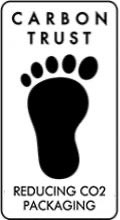

Image Source: CarbonTrust.com
Moving forward, we anticipate that brand owners and their suppliers will be pressured to address the carbon footprint of their products and their packaging (including its inks and coatings) in a more transparent way. After all, it’s become second nature to check the calorie, sugar, salt, and fat content of food or drinks before buying them. To Learn more about ways inks can reduce carbon emissions read our blog post: Using Eco-Friendly Inks to Reduce Carbon Footprint.
Recyclability & Waste Reduction
All of the 25-largest CPG companies have made commitments to increasing recyclable content, minimizing packaging, or reusing material. Eighty percent (80%) of those companies are working toward fully recyclable packaging for all of their products by 20303. According to a March 2021 article by McKinsey & Company, improving packaging recyclability and increasing the use of recycled content in packaging are two (of five) key trends that will shape sustainable packaging and brand investments in the next few years4. Inks and coatings are integral to packaging recyclability yet there are several additional variables to consider including: the packaging substrate the ink is printed on, the efficiency of the pressroom, the efficiency of the ink—can a single ink be used on multiple platforms to improve productivity?—the packaging system being used, and so on. These variables must be evaluated together when determining the environmental impact of packaging.
When fiber-based packaging is processed during recycling, it undergoes a process called de-inking, which cleans the fibers of ink so they can be reused. Some inks are more eco-friendly than others. Although the inks and coatings may only be a small percentage of the overall package, they should typically be tested together with the package in order to determine the degree to which the package is sustainable and ensure that the inks and coatings used do not inhibit the recycling and/or reuse process. The ink and coating industry has made tremendous progress over the last several years; today, there are a variety of innovative inks and coatings that can be recycled and/or do not impede the recycling process, including:
- Washable inks that are easily removed in the recycling process and provide significant environmental, efficiency, and print benefits. Recognized by the Association of Plastic Recyclers, INX Genesis™ GS washable inks make it easier to recycle plastic films used in packaging. The high-performance ink is de-inkable from shrinkable cPET films and the ink will stay on OPP film designed for roll-fed labels. Minimal bleed in the caustic wash step of the recycling results in negligible impact on recycled PET discoloration allowing for increased recovery of high-quality, clean, recycled PET resin flakes. New PET bottles can be made from the circular reuse of recovered material and contribute to a circular economy, boost the worldwide recycling rate, and reduce the volume of plastic bottles in the marine environment.
- High-performance, gel-based ink technologies eliminate the challenge of recycling multiple layers laminated together in plastic packaging. Our GelFlex™ EB (electron beam) curable flexographic inks let you reduce or eliminate lamination layers. With its low VOC levels, its gel-based technology allows ink to adhere almost instantly to a substrate by way of a covalent bond which results in no color bleed. In its reaction with an e-beam, Gelflex-EB crystallizes and cross-links polymer chains to create a contiguous and homogenous layer of polymerized print.
Recycling non-fiber packaging, such as printed bottles, labeled bottles, and printed films requires the recycling sorting machines to identify the type of label that is attached, including any adhesive used. Removing adhesives is often a significant component of recycled packaging. If a metal foil or a metalized label is used, additional testing may be required before determining whether or not the package/bottle/can is recyclable. A number of resins, inks, and adhesives have received recognition from the APR (APR Design Recognition)—including Genesis GS (mentioned above)5. INX International offers a complete line of flexographic and gravure inks and coatings including energy curable options for shrink sleeve applications and recyclable options for PET bottles.
LINK
Genesis makes recycling plastic films used in packaging more efficient.
See if Genesis is right for you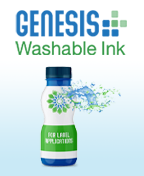
Ink is often thought to be obsolete and unable to be reused. Ink waste is a disposal cost for the printer/converter, and having waste means that more raw materials were purchased than necessary. Although there are times when it is not possible to reuse an ink and/or coating, more often than not, we are able to find an alternative use for the ink. It is rarely ‘waste’ or wasted. When it comes to reuse, INX has several tools which help our customers optimize inventory and redeploy obsolete product. Below are four ways ink and coating suppliers—as well as printers and converters—can reduce the volume of waste they generate and manage ink waste to provide cost and sustainability benefits for themselves and their customers.
- Many packaging converters use more than one (or two, or three) ink systems. Offering a single ink system that is able to be used for multiple applications not only helps printers’ (and their customers) bottom line, it also boosts their environmental positioning.
- Ink and Coating Waste Reduction Programs are focused on improving the utilization of in-bound materials and optimizing end-of-life printed products. Our proprietary INXManager® Software helps our customers with color management as well as overall inventory and waste control, and it enables the reuse of excess or obsolete ink and reduces print waste.
- Ink Dispensing Systems help reduce and eliminate expensive waste by making only what is needed for each job and working off excess inventory. INX offers a variety of ink dispensers for flexographic, conventional, and UV offset inks.
- Direct to Object Printing can eliminate a label substrate and produce a decorated piece with less waste and no make-ready. INX Digital is leading the technology development and implementation of direct-to-object digital inkjet printing for decoration and packaging applications.
Compliant, Clean Packaging & Low Migration Inks
A focus on clean, contaminate-free packaging and food safety is at an all-time high and will remain a priority for consumers, brand owners, and retailers well into the future. Recalls have definitely heightened consumer awareness of the food supply chain and the requirement for clean, food-safe packaging. Minimizing risks to the consumer and ensuring their packaging is compliant with global regulations and industry standards—as well as their own brand standards—is becoming increasingly complex for brand owners and packaging converters. Ensuring that packaging ink does not migrate to the food product enclosed within the package is crucial to supplying food-safe packaging.
Migration is the transfer of various components from the finished packaging to the food product. These components can originate from anything that may have been in contact with the product such as the environment, packaging material, or substrate, inks, adhesives, varnishes, and coatings. Often, migration cannot be detected by odor or taste but instead must rely upon chemical analysis to identify if any migration has occurred. Migration from printing typically occurs in three different ways:
- Penetration through the substrate
- Set-off transfer to the reverse/food contact side of a stack or reel
- Migration via vapor (gas) phase transfer
Migration is typically measured using gas or liquid chromatography with mass spectroscopy equipment. These measurements identify and quantify substances which have transferred from the package to the food product. Migration analysis models are typically dependent on the food within the package, storage conditions, and package design. Results are usually measured in ug/dm² and converted to parts per billion (ppb) over a defined surface area. To meet target compliance requirements, migration studies should be performed by an accredited independent laboratory. Depending on risk assessment, ongoing migration testing should be performed to ensure compliance over time in accordance with current industry and government requirements.
Low migration inks and coatings are specifically designed and tested for use in food packaging applications sensitive to migration issues. When used correctly for their intended application, the migration of ink is minimized. INX International’s low migration food packaging inks are manufactured in accordance with the requirements of Good Manufacturing Practice. Our raw materials are carefully selected according to “(PDF) EuPIA Guideline on Printing Inks applied to the non-food contact surface of food packaging materials and articles.” Accordingly, our food packaging inks are formulated without SVHC (Substance of Very High Concern), CMR (Carcinogen, Mutagen or Reproductive Toxin), heavy metals, and toxic or very toxic substances. At INX, there is nothing more important than the safety and welfare of our employees, customers, and consumers. All facets of our business, from research and development, product stewardship, and quality, work together to ensure that our packaging inks are of the highest quality and meet or exceed both regulatory and brand standards.
To learn more about Food Safe Packaging Inks read our blog post: Food Safe Packaging & Inks: 5 Tips.
Regulations, NGOs, & Certifications
Coupled with increased consumer awareness and expectations around sustainability, growing regulatory demands, and pressure from NGOs (non-governmental organizations) have also contributed to the burden of brand owners to improve the sustainability performance of their products and packaging. Regulators worldwide are adopting various approaches to minimize and manage package waste.
For example, there is an ongoing push to introduce more packaging responsibility or product stewardship bills, broadly referred to as EPR, across the U.S. EPR programs already exist for a variety of products like paint, carpet, batteries, mattresses, and pharmaceuticals; yet there are no state EPR programs for packaging (though there are bottle deposit/return policies regulated state by state). Lawmakers and other groups are interested in shifting recycling costs away from taxpayers and onto product packaging producers. Several states (California, Hawaii, Maryland, Massachusetts, New York, Oregon, Washington) have active EPR bills and several others (Colorado, New Hampshire, Vermont, Maine) are expected to introduce EPR legislation in the near future6.
Another illustration of the scale and compelling influence on the world’s consumer brands and packaging producers is the United Nations 2030 Agenda for Sustainable Development and its associated 17 UN Sustainable Development Goals (SDGs) and 169 targets. The 2030 Agenda for Sustainable Development, adopted by all United Nations Member States in 2015, provides a shared blueprint for peace and prosperity for people and the planet, now and into the future. At its heart are the 17 Sustainable Development Goals (SDGs), which are an urgent call for action by all countries —developed and developing—in a global partnership7.
At INX, we have created a model—Coloring a Safe and Sustainable Future (CSSF)—to guide us as we work to improve our sustainability performance and contribute to a circular economy while addressing the needs of brand owners, customers, and consumers. It identifies the key initiatives we will continue to invest in as we promote the tenets of a circular economy. Additionally, it supports the United Nations 2030 Agenda and also identifies and aligns UN SDGs with our three main areas of impact: Product Design, Process Design, and Social Responsibility.
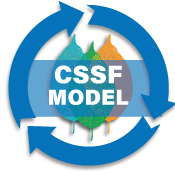

We are committed to manufacturing, delivering, and applying our products using the least amount of resources while reducing the amount of carbon emissions.
- Energy & Utility
- Manufacturing & Shipping Efficiencies
- Process Waste Reduction
- Carbon Emission Reduction

Ensure access to safe water sources and sanitation for all

Ensure access to affordable, reliable, sustainable and modern energy for all

Build resilient infrastructure, promote inclusive and sustainable industrialization and foster innovation

Ensure sustainable consumption and production patterns

We are committed to formulating safe and sustainable products that have minimal impact on the environment without sacrificing end use performance.
- Sustainable Sourcing & Supply
- Product Quality & Material Health
- Recycle-Ready End-of-Life
- Product Functionality

Ensure sustainable consumption and production patterns

Taking urgent action to tackle climate change and its impacts

Conserve and sustainably use the world's ocean, seas, and marine resources

Sustainably manage forests, combat desertification, halt and reverse land degradation, and halt biodiversity loss

Ensure healthy lives and promote well-being for all at all ages

Promote inclusive and sustainable economic growth, employment, and decent work for all

Reduce inequalities within and among countries

Make cities inclusive, safe, resilient, and sustainable
Within the packaging and CPG industries, there are many different organizations, certifications, and standards related to recyclability, sustainability, and the circular economy. A few of these were mentioned in the introduction (Green Seal, FSC and SFI). Yet unlike other materials, ink does not have any standard certifications, though there are a few organizations and certifications worth mentioning. (List not exhaustive.)
- Global:
- The Ellen MacArthur Foundation’s mission is to accelerate the transition to a circular economy. They work with global business, academia, policymakers, and institutions to mobilize systems solutions.
- UL ECOLOGO Certification is a globally recognized eco-label whose range of standards are recognized in more than 150 rating systems and specifications and are also included in procurement language.
- The Association of Plastic Recyclers (APR) Postconsumer Resin (PCR) Certification Program is a process to endorse companies that provide third-party certification of PCR and promote APR member companies that receive certification. The APR is an international trade association representing the plastics recycling industry.
- In the U.S.:
- The National Association of Printing Ink Manufacturers (NAPIM) assigns a Biorenewable Content number (BRC) to an ink. This number indicates how much of a given ink is sourced from bio-renewable resources.
- A relatively new certification program is offered by The Sustainable Green Printing Partnership (SGGP), a non-profit organization that certifies printing facilities’ sustainability best practices, including and beyond regulatory compliance.
- Ameripen is an industry and trade organization with an economic interest in packaging and packaged products. It provides public policy makers with fact-based, material neutral, scientific information.
- The Sustainable Packaging Coalition is a membership-based collaborative whose mission is to bring packaging sustainability stakeholders together to catalyze actionable improvements to packaging systems and to lend an authoritative voice on issues related to packaging sustainability.
- In Europe:
- The European Printing Ink Association (EuPIA) represents the interests of European manufacturers of printing inks and related products.
In the foreseeable future, we anticipate that regulatory issues related to package and product sustainability will remain a challenge for brand owners and packaging converters. The momentum of sustainability-related legislation, NGOs, and certifications has forced brands and their packaging supply chain partners to take an active role in influencing the laws and standards that will most definitely impact their products and packaging. Further illustrating this is the Consumer Brands Association, which represents CPG brands in the U.S. and who recently published its first policy platform: Achieving America’s Recycling Future. And, in February, 2021 it released its vision for federal policy actions related to recycling. Clearly, staying on the sidelines isn’t an option for the brands (and their print and packaging partners) whose products consumers depend on every day.
Conclusion
Sustainability is at the top of every leader’s agenda. Leaders are resolute in their desire to drive growth with an environmentally conscious impact; and the links between sustainability performance and financial performance are fast becoming closely connected. As an industry leader with decades of experience providing customers from a variety of industries with a full line of ink and coating solutions and technologies, we understand how our products can impact consumer safety, brand marketability, and the environment. Supporting the circular economy is essential to driving product and package sustainability.
At INX International, we realize that doing our part to create circularity is key to sustainably shaping the future of the print and packaging industry. We understand how we fit into the bigger sustainability picture with consumers, brand owners, converters, and our planet. We get to know your business as if it’s our own and work to fully understand the value of your portfolio to identify the best opportunities.
Learn more about how our inks and coatings may help you achieve your sustainability goals and access our library of literature, case studies, and videos about our approach to sustainable print and packaging and the advantages of using our eco-friendly ink products.
1Based on EUPIA dry ink baseline for aqueous based inks of 3.092kg CO2/kg dry ink.
2Carbon Trust; Product Carbon Footprint Label
4McKinsey & Company; Sustainability in packaging: Investable themes
5The Association of Plastic Recyclers; Labels, Inks, Adhesives
62021 could be year for packaging EPR, nearly a dozen state bills in play; Waste Dive






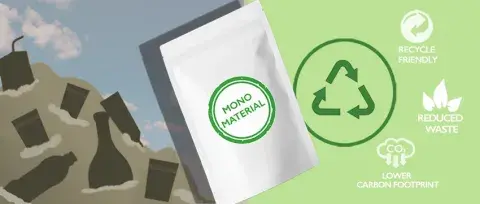

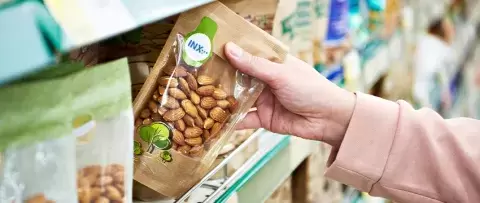



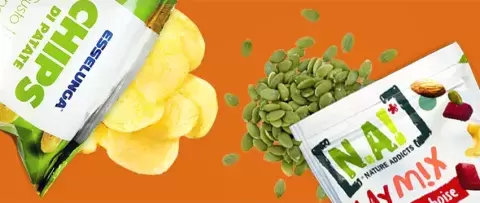
We carry out corporate social responsibility activities with an awareness of the social, environmental, and economic impacts, pursuing a good balance and interaction among the three aspects.